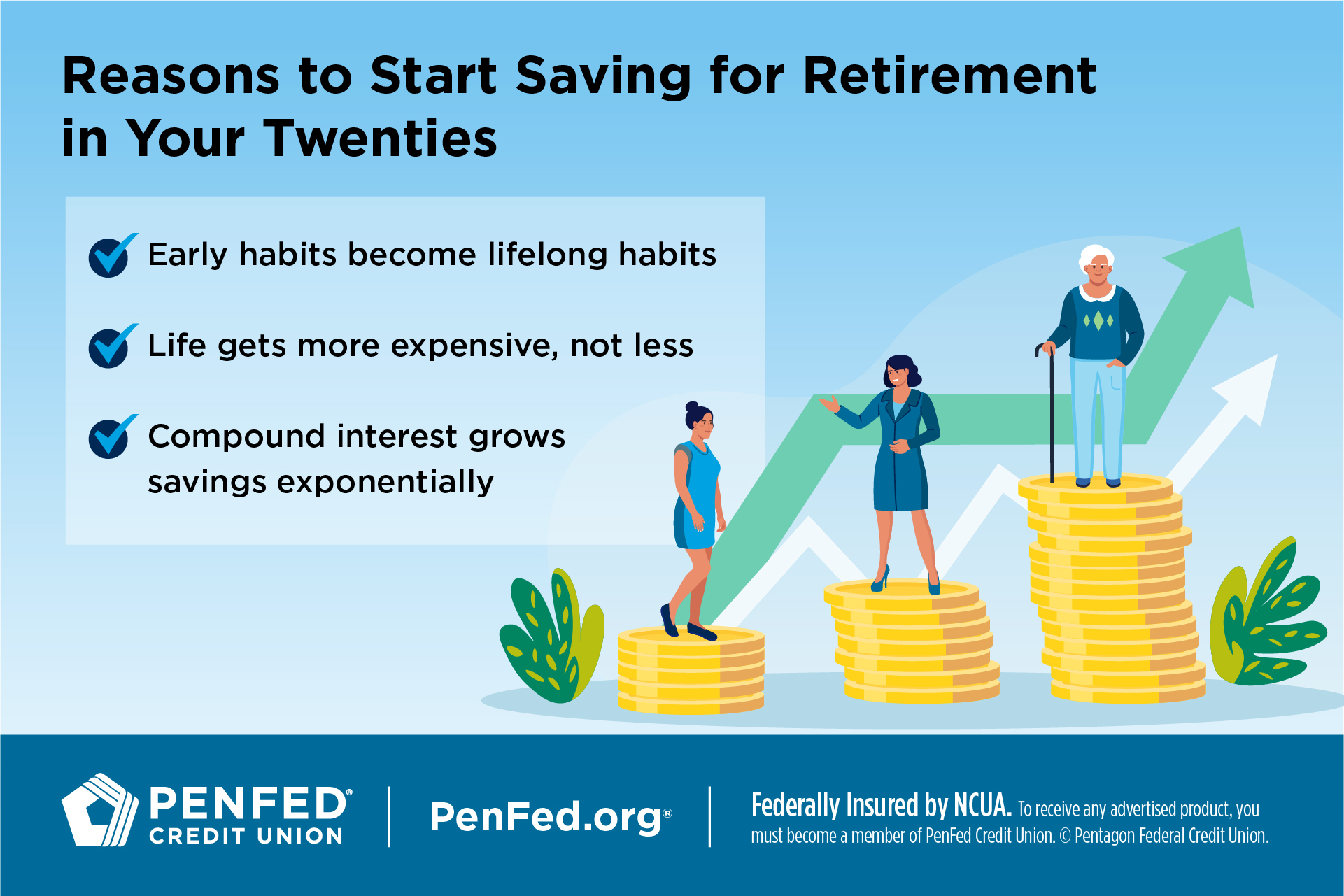Finance
How to Start Saving for Retirement in Your Twenties
EXPECTED READ TIME:7 MINUTES
It may be hard to picture retirement when you’re just starting a career, but elder you will be grateful that you did. Many Americans underestimate the amount of money they’ll need to retire, and many experts agree that social security isn’t enough for many retirees to live on without another source of income.
Saving for retirement might be intimidating, especially if money is tight. The good news is there are two things you can do to give yourself a leg up: start early and save consistently.

Why You Should Start Saving Early
Early Habits Become Lifelong Habits
Habits set when we’re young are more likely to stick later in life. If you make saving for retirement a habit when you’re first starting your career, it’s more likely to stick throughout your career.
Life Gets More Expensive
Another reason to start early is that living expenses tend to increase as we age. You might replace your car, pay more for food or rent, buy a house, or start a family. Some people put off saving for retirement thinking it’ll get easier down the line, but that’s not always the case.
Habits set when we’re young are more likely to stick later in life.
Time and Compound Interest/Dividends
But the biggest reason to start saving for retirement early is because of compound interest or dividends. Compound interest (or dividends) is interest you earn on the money you originally saved (the principal) plus the interest/dividend you earn on the original amount saved.
In other words, if you put $100 into a savings account, the first month you’ll earn interest on $100. But the next month you’ll earn interest on $100 plus whatever that money earned the previous month.
Compound interest (or dividends) is interest you earn on the money you originally saved (the principal) plus the interest/dividend you earn on the original amount saved.
Compound Interest/Dividends in Action
Exactly how much of a difference does compound interest/dividends make? Let’s look at two examples.
Mai decides to save $50 each month for retirement starting when she’s 22. By the time she turns 50, she’ll have saved $16,800. But with compound interest, she’ll actually end up with much more. Assuming a modest 8% return compounded monthly, she’ll have $62,894.41 in her account.
Mai’s friend Taylor is inspired by her success. He starts putting $50 into retirement monthly, also at an 8% return compounded monthly — but he doesn’t start until he’s 29. When Taylor turns 50, he’ll have only $32,784.72 saved.
|
|
Monthly Contribution |
% Return on Investment |
Years Saved |
Total Retirement Income |
|---|---|---|---|---|
|
Mai |
$50 |
8% |
28 |
$62,894.41 |
|
Taylor |
$50 |
8% |
21 |
$32,784.72 |
These scenarios show us that compound interest works best over time. The longer you wait to start saving for retirement, the harder it will be to catch up on missed funds. But Taylor’s situation isn’t hopeless. He can retire with the same amount of money as Mai by increasing his monthly contribution to $95. So even if you feel like you’re starting late, you haven’t missed your chance at building a healthy retirement fund.
Even if you feel like you’re starting late, you haven’t missed your chance at building a healthy retirement fund.
How to Start Saving for Retirement
You might be thinking, “Sure, saving money for retirement sounds nice, but where is that money coming from?” And that’s absolutely a valid question. You likely juggle many expenses, and just cutting out your morning soy matcha latte won’t do the trick. So here are some real suggestions.
Create a Budget
Even if you don’t have a lot of money, or what you make is spread thin, a budget will help you make the most of what you have. It helps you see where your money is going, be more intentional with spending, and decide where you can redirect some funds. You can make a budget in six steps, and there are ways you can learn to stick to your budget better.
Just cutting out your morning soy matcha latte won’t do the trick.
Make a Plan for Your Debt
Whether it’s student loans or credit cards, debt can be a big barrier to saving for retirement. The first step to removing that barrier is taking control of your debt and creating a plan for managing it. Choose a strategy for paying off your credit cards. Consider whether debt consolidation or a balance transfer would simplify things. Commit to paying off your car loan faster or refinancing your student loans. There are tools out there to help — you just have to find them.
Set a Realistic Savings Goal
Many experts advise saving 10-15% of your pre-tax income for retirement, but that might be too hard right now — and that’s ok. Even if you can only manage $25 per month, that’s a start! You can always raise your goal when you can afford to, but don’t let a huge goal put you off from saving something.
Don’t let a huge goal put you off from saving something.
Make More Money
Just under half of Americans today have side hustles. People are using this extra income to do anything from pay down debt to travel the world — even to save for retirement. While that might not be the most exciting way to use your money, it’s an important investment in your long-term well-being.
Ways to Maximize Your Retirement Savings
Realistically, you can only save so much per month. That’s why it’s important to maximize your savings and take full advantage of ways you can grow them.
Participate in Your Company’s Retirement Plan
Many employers offer retirement plans such as a 401(k) that automate your saving by having a pre-approved percentage taken from each paycheck and deposited into your retirement account. These plans often come with tax incentives, too, allowing you to deposit money pre-tax.
Employer Match
Many employers will match your retirement contribution up to a certain percentage of your monthly income. This money is part of your compensation package. If you’re not contributing the maximum amount they’ll match, then you’re basically not claiming your whole paycheck.
Employer matches sometimes change depending on raises, promotions, or your tenure with a company. If your match percent increases, obviously you’ll want to increase your monthly contribution to keep maxing out that match.
If you’re not contributing the maximum amount they’ll match, then you’re basically not claiming your whole paycheck.
How Much Is an Employer Match Worth?
Let’s look at Michael’s retirement with and without his employer’s matching funds. Michael earns $50,000 per year and his employer offers a 3% match. Michael chooses to put in 5% himself. Like Mai and Taylor, he earns a modest 8% return compounded monthly.
|
|
Yealy Contribution |
% Return on Investment |
Years Saved |
Total Retirement Income |
|---|---|---|---|---|
|
Without employer match |
$2,500 |
8% |
30 |
$337,334.09 |
|
With employer match |
$4,000 (Michael’s $2,500 + $1,500 employer contribution) |
8% |
30 |
$540,032.62 |
Self-Funded Retirement Options
There are options if your employer doesn’t offer retirement benefits. In fact, there are lots of options beyond 401(k) or pension plans. The 17 types of retirement plans identified by the IRS vary a lot, so speak with an expert if you need help choosing the right one for you. Below are some of the most common self-funded options.
IRAs vs. Roth IRAs
One of the most popular retirement account options is the Individual Retirement Account, or IRA. This is a specialized account where you save and invest money for retirement. There are four types of IRAs to choose from depending on your retirement goals.
Certificates
Certificate accounts are secured with predictable, guaranteed yields. They offer higher rates than savings accounts, and you can grow your savings fast with the right certificate strategy.
Investing
Investing can be risky, but potentially offers big payoffs. Some investments, like bonds, are safer than others with lower yields.
While many retirement accounts are managed for you, you’ll have to manage a brokerage account yourself or hire someone to do it for you.
Many retirement accounts like 401(k)s and IRAs are forms of investing, but you can also open a separate brokerage account if you want to invest more than your retirement account allows. While many retirement accounts are managed for you, you’ll have to manage a brokerage account yourself or hire someone to do it for you.
Health Savings Account (HSA)
A health savings account (HSA) is a tool for saving pre-tax money for future health expenses. However, some people use it as a supplemental retirement account. You can invest the money in your HSA without having to pay taxes on what it earns. Then at age 65, you can withdraw these funds to cover medical or other expenses.
At age 65, you can withdraw HSA funds to cover medical or other expenses.
The Takeaway
Retirement planning is intimidating because it can be complicated. Starting early is the best way to simplify the process, and now you have the knowledge to start planning for the life your future self deserves.
Get Ahead of Retirement With a PenFed IRA
Discover the diverse offering of products, services, and support available to our members.




